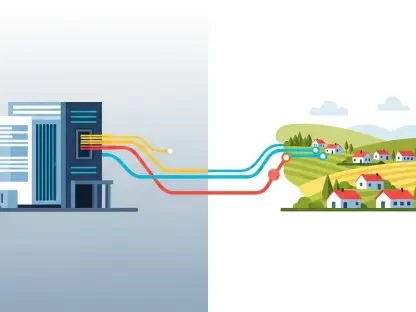In a striking revelation about the economic landscape of Ohio, a recent study conducted by the Ohio Chamber of Commerce Research Foundation has unveiled the profound impact of data centers on the state’s financial health, highlighting their emergence as a powerhouse rivaling long-standing industries like automotive and agriculture. With major tech giants establishing massive campuses across the region, Ohio is rapidly becoming a focal point for technological innovation. This surge not only underscores the state’s growing role in the global tech market but also raises critical questions about how to sustain such rapid expansion. The findings paint a picture of immense opportunity, tempered by the need for strategic planning to manage the accompanying challenges.
Economic Powerhouse of the Digital Age
Unprecedented Growth and Job Creation
The data center industry in Ohio has demonstrated remarkable economic influence, supporting nearly 95,000 jobs and contributing a staggering $12 billion to the state’s GDP as of the latest figures. Projections indicate that by 2030, these numbers could swell to over 130,000 jobs and $20 billion, signaling a robust upward trajectory. This growth is driven by significant private investments totaling $40 billion, which have poured into the state, creating a ripple effect across multiple sectors. Beyond direct employment in tech, the industry has spurred opportunities in construction, logistics, and other related fields. Columbus, in particular, stands out as the fourth-largest data center market globally and the second in the United States, trailing only northern Virginia. This positioning underscores Ohio’s critical role in the digital economy, where every dollar of state tax incentives generates more than double in state and local tax revenue, amplifying the financial benefits for communities statewide.
Long-Term Economic Benefits
Beyond the immediate job surge, the data center sector promises enduring economic stability for Ohio. The study’s lead researcher emphasized that while construction phases currently drive much of the employment boom, steady, long-term positions are expected to solidify over time. Annual tax revenue from this industry has already soared to over $1 billion, providing a substantial fiscal boost to public services and infrastructure development. Major players like Amazon Web Services, Google, and Meta have anchored their operations in the state, fostering a network of innovation that attracts further investment. These economic gains are not confined to direct impacts; indirect and induced effects stimulate growth in related industries, from local suppliers to service providers. This interconnected prosperity highlights the industry’s potential as a sustainable driver of wealth, provided that Ohio continues to nurture the conditions necessary for such expansion to thrive without disruption.
Challenges on the Horizon
Infrastructure Strain and Resource Demands
As Ohio’s data center industry flourishes, it places unprecedented demands on the state’s infrastructure, particularly in terms of energy and water resources. The cooling systems required to keep these facilities operational consume vast amounts of water, creating pressure even in a state with relatively abundant supplies. More pressing is the challenge of energy consumption, with unpredictable electricity needs complicating long-term planning for utilities. Modernizing the power grid is no longer optional but a critical necessity to maintain competitiveness in this sector. Without significant upgrades, the risk of outages or inefficiencies could deter future investments. The study underscores the importance of proactive measures to address these resource constraints, ensuring that the infrastructure can keep pace with the industry’s rapid growth while minimizing environmental and operational risks that could undermine progress.
Building Trust and Workforce Readiness
Addressing the infrastructure challenges is only part of the equation; Ohio must also focus on workforce development and community engagement to sustain the data center boom. Investing in specialized training programs is essential to prepare a skilled labor pool capable of meeting the technical demands of this industry. Equally important is fostering transparency through performance metrics and accountability measures, such as clawback provisions in incentive agreements, to ensure that economic benefits are equitably shared. Building public trust is vital, as local communities need assurance that the industry’s growth will not come at the expense of their quality of life. By prioritizing these efforts, Ohio can create a supportive ecosystem where the data center sector continues to thrive. Strategic planning in these areas will help mitigate potential backlash and ensure that the economic windfall translates into broad-based prosperity for residents across the state.
Reflecting on a Transformative Impact
Lessons from a Digital Revolution
Looking back, the rise of data centers in Ohio marked a pivotal shift in the state’s economic identity, blending traditional industrial strengths with cutting-edge technology. The billions in revenue and tens of thousands of jobs supported by this sector in recent years stand as a testament to its transformative power. Yet, the journey was not without hurdles, as energy demands and resource constraints tested the state’s readiness to adapt. The insights gained from balancing these economic gains with infrastructural challenges offer valuable lessons for other regions eyeing similar growth. Ohio’s experience highlights the importance of foresight in managing such a dynamic industry, ensuring that the benefits reach far beyond corporate balance sheets to enrich entire communities.
Planning for Sustainable Prosperity
As reflections on this era crystallized, the path forward became clear: Ohio must prioritize strategic investments in grid modernization, water management, and workforce training to secure the future of its data center industry. Collaborative efforts between state leaders, industry stakeholders, and local communities are deemed essential to address these ongoing needs. By implementing robust policies and fostering innovation in resource management, Ohio positions itself to maintain its status as a digital hub. The focus has shifted to creating a blueprint for sustainability, ensuring that the economic momentum of past achievements continues to drive progress. This proactive stance promises to safeguard the industry’s legacy, turning challenges into opportunities for lasting growth and resilience.









